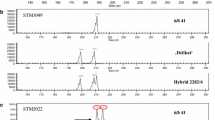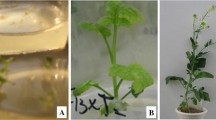Summary
Asymmetric somatic hybrid plants between Brassica napus L. (oilseed rape genome AACC) and a transgenic line of Brassica nigra L. Koch (black mustard genome BB) were tested for their resistance against rapeseed pathogens Phoma lingam (black leg disease) and Plasmodiophora brassicae (club root disease). The transgenic B. nigra line used (hygromycin-resistant, donor) is highly resistant to both fungi, whereas B. napus (recipient) is highly susceptible. The asymmetric somatic hybrids were produced using the donor-recipient fusion method (with X-irradiation of donor protoplasts) reported by Zelcer et al. (1978) for the production of cybrids. Using hygromycin-B for selection, a total of 332 hybrid calli were obtained. Regenerants, resistant or susceptible to both diseases, were selected. Many hybrids expressed resistance to only one pathogen. Dot blot experiments showed that the asymmetric hybrid plants contained varying amounts of the donor genomic DNA. Furthermore, a correlation was detected between the radiation dose and the degree of donor DNA elimination.
Similar content being viewed by others
References
Anamthawat-Jónsson K., T. Schwarzacher, A.R. Leitch, M.D. Bennet & J.S. Heslop-Harrison, 1990. Discrimination between closely related Triticeae species using genomic DNA as a probe. Theor. Appl. Genet. 79: 721–728.
Arumuganathan K. & E.D. Earle, 1991. Nuclear DNA content of some important plant species. Plant Mol. Biol. Rep. 9: 208–218.
Bauer R., 1990. Somatic plant hybridization—a review. Arch. Züchtungsforsch. 1: 66–79.
Buczacki S.T., H. Toxopeus, T.D. Mattusch, G.R. Dixon & L.A. Hobolt, 1975. Study of physologic specialization in Plasmodiophora brassicae: proposals for attempted rationalization through an international approach. Trans Br. Mycol. Soc. 65: 295–303.
Chuong P.V., K.P. Pauls & W.D. Beversdorf, 1987. Protoplast culture and plant regeneration from Brassica carinata Braun. Plant Cell Rep. 6: 67–69.
Crisp P., I.R. Crute, R.A. Sutherland, S.M. Angeli, K. Bloor, H. Burgess & P. Gordon, 1989. The exploitation of genetic resources of Brassica oleracea in breeding for resistance to clubroot (Plasmodiophora brassicae). Euphytica 42: 215–226.
Gamborg O.L., R.A. Miller & K. Ojima, 1968. Nutrient requirements of suspension cultures of soybean root cells. Exp. Cel Res. 50: 151–158.
Gerdemann-Knörck M., M.D. Sacristán, C. Braatz & O. Schieder, 1994. Utilization of asymmetric somatic hybridization for the transfer of disease resistance from Brassica nigra to Brassica napus. Plant Breeding. 113: 106–113.
Glimelius K., C. Fahlesson, M. Landgren, C. Sjödin & E. Sundberg, 1991. Gene transfer via somatic hybridization in plants. Trends in Biotech. 9: 24–30.
Gupta V., V. Jagannathan & S. Lakshmikumaran, 1990. A novel AT-rich tandem repeat of Brassica nigra. Plant Sci. 68: 223–229.
Gupta V., G. LakshmiSita, M.S. Shaila, V. Jagannathan & S. Lakshmikumaran, 1992. Characterization of species specific repeated DNA sequences from B. nigra. Theor. Appl. Genet. 84: 397–402.
Heslop-Harrison J.S., G.E. Harrison & I.J. Leitch, 1992. Reprobing of DNA: DNA in situ hybridization preparations. Trends in Genetics 8: 609–614.
Imamura J., M.W. Saul & I. Potrykus, 1987. X-ray irradiation-promoted asymmetric somatic hybridisation and molecular analysis of the products. Theor. Appl. Genet. 74: 445–450.
Jacobsen B.J. & P.H. Williams, 1970. Control of cabbage clubroot using benomyl fungicide. Plant. Dis. Rep. 54: 456–460.
Labarca C. & K. Paigen, 1980. A simple, rapid and sensitive DNA assay procedure. Anal. Biochem. 102: 344–352.
Li L.C. & H.W. Kohlenbach, 1982. Somatic embroygenesis in quite a direct way in cultures of mesophyll protoplasts of Brassica napus L. Plant Cell Rep. 1: 209–212.
Murashige T. & F. Skoog, 1962. A revised medium for rapid growth and bio assays with tobacco tissue cultures. Physiol. Plant. 15: 479–497.
Otten L. & R.A. Schilperoort, 1978. A rapid microscale method for the detection of lysopine and nopaline dehydrogenase activities. Biochem. Biophys. Acta 527: 497–500.
Roger S.O. & A.J. Bendich, 1985. Extraction of DNA from milligram amounts of fresh, herbarium and mummified plant tissues. Plant Mol. Biol. 5: 69–76.
Sacristán M.D., 1982. Resistance response to Phoma lingam of plants regenerated from selected cell and embryogenic cultures of haploid Brassica napus. Theor. Appl. Genet. 61: 193–200.
Sacristán M.D. & F. Hoffmann, 1979. Direct infection of embryogenic tissue cultures of haploid Brassica napus with resting spores of Plasmodiophora brassica. Theor. Appl. Genet. 54: 129–132.
Sacristán M.D. & M. Gerdemann, 1986. Different behaviour of Brassica juncea and B. carinata as source of Phoma lingam resistance in experiments of interspecific transfer to B. napus. Plant Breeding. 97: 304–314.
Sacristán M.D., M. Gerdemann-Knörck & O. Schieder, 1989. Incorporation of hygromycin resistance in Brassica nigra and its transfer to B. napus through asymmetric protoplast fusion. Theor. Appl. Genet. 78: 194–200.
Schieder O., M. Gerdemann-Knörck & M.D. Sacristán, 1991. The use of protoplast fusion and transformation for the production of asymmetric somatic hybrids. Israel J. Bot. 40: 99–107.
Schieder O. & H. Kohn, 1986. Protoplast fusion and generation of somatic hybrids. p. 569–588. In: I. Vasil (Ed). Cell Culture and Somatic Cell Genetics of Plants. Vol. III. Academic Press Inc., Orlando.
Sjödin C. & K. Glimelius, 1989. Transfer of resistance against Phoma lingam to Brassica napus by asymmetric somatic hybridization combined with toxin selection. Theor. Appl. Genet. 28: 513–520.
Trick H., A. Zelcer & G.W. Bates, 1994. Chromosome elimination in asymmetric somatic hybrids: effect of gamma dose and time in culture. Theor. Appl. Genet. 88: 965–972.
Tzcheetzsch, C., 1993. Reklonierung asymmetrischer Hybriden von Brassica napus (+) Brassica nigra. Diploma thesis, FU Berlin.
Zelcer A., D. Aviv & E. Galun, 1978. Interspecific transfer of cytoplasmatic male sterility by fusion between protoplasts of normal Nicotiana sylvestris and X-ray irradiated protoplasts of male sterile N. tabacum. Z. Pflanzenphysiol. 90: 397–407.
Zhu J.S. & A. Spanier, 1991. Resistance sources to Phoma lingam and Alternaria brassicae. Cruciferae Newsl. Eucarpia 14/15: 143.
Zhu J.S., D. Struss & G. Röbbelen, 1993. Studies on resistance to Phoma lingam in Brassica napus-Brassica nigra addition lines. Plant Breeding 111: 192–197.
Author information
Authors and Affiliations
Rights and permissions
About this article
Cite this article
Gerdemann-Knörck, M., Nielen, S., Tzscheetzsch, C. et al. Transfer of disease resistance within the genus Brassica through asymmetric somatic hybridization. Euphytica 85, 247–253 (1995). https://doi.org/10.1007/BF00023953
Issue Date:
DOI: https://doi.org/10.1007/BF00023953




